Empress Joséphine's Coronation Ensemble
Empress Joséphine of France lived an extraordinary life, and it all began on June 23, 1763 on the island of Martinique. She was born Marie Josèphe Rose Tascher de La Pagerie (she was called Rose until Napoléon bestowed her with the name Joséphine) to wealthy French Creole sugarcane plantation owners. Before meeting her future husband Napoléon Bonaparte, she had already been married (her first husband died at the guillotine), given birth to two children, and survived her 1794 imprisonment during the Reign of Terror. Just one year later, she met Napoléon and became his mistress. He was intensely infatuated with her, and the two were married in March 1796. As Napoléon rose politically, it became increasingly important that Joséphine present herself as a worthy partner of France’s newest leader; she quickly became an arbiter of taste in the upper echelons of society.
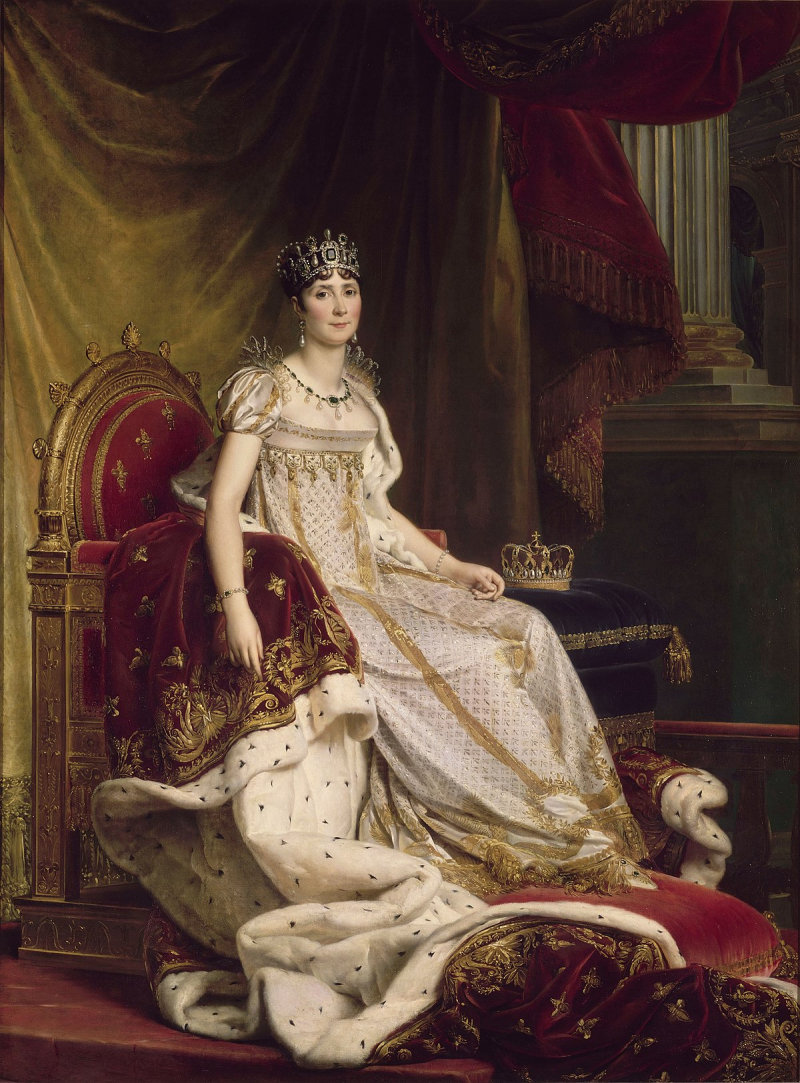 Baron François Gérard, "Joséphine en costume de sacre," 1807-1808. Château de Fontainebleau.
Baron François Gérard, "Joséphine en costume de sacre," 1807-1808. Château de Fontainebleau.
At the turn of the 19th century, fashion was in flux; simple neoclassical silhouettes dominated, representing a commitment to democracy and a rejection of the Ancien Régime and its excessive grandeur. Yet unadorned garments made of humble fabrics hurt France’s once flourishing textile and fashion industry, which diminished greatly after the Revolution. Napoléon saw his return to court as an economic opportunity to revive textile manufacturing, and in 1802 he mandated a formal dress code at all court functions – thus instilling a need for skilled dressmakers, Lyon’s sumptuous silks, and lavish embroidery. Muslin garments were no longer allowed at court, as they came to France from India via England, a rival European textile center. Determining what exactly constituted court dress was still in question. Combining contemporary styles with the necessary splendor of court was a difficult balancing act post-Revolution. Eighteenth-century royal attire was steeped in the past, but France’s new society demanded fashionable silhouettes while maintaining the requisite luxury. Napoléon’s coronation in 1804 provided a singular opportunity to define court dress for all of France – in fact, Joséphine’s costume at this momentous event would influence European court fashions for years to come.
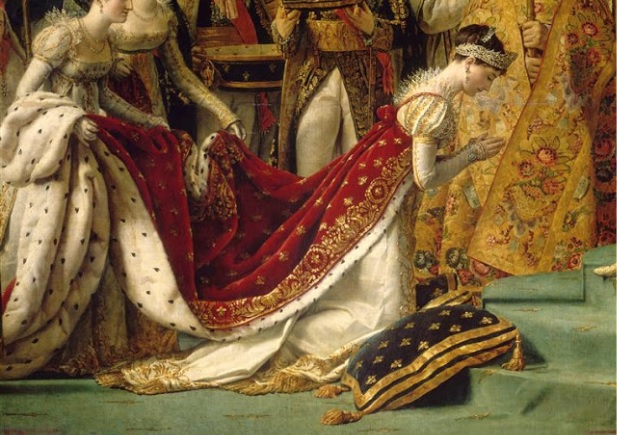
Jacques-Louis David. "Fragment: the coronation of the Emperor Napoléon I and coronation of Empress Joséphine in Notre-Dame de Paris, 2 December 1804," 1807. Louvre Museum.
The stakes of the coronation were high, as it was essential for Napoléon to legitimize his fledgling regime. Both Napoléon and Joséphine’s ensembles incorporated symbolism to associate their reign with France’s great history and traditions, while also introducing original iconography to signify a new era of imperial rule. Jean-Baptiste Isabey designed Joséphine’s gown, and Louis Hippolyte LeRoy, Joséphine’s favored marchand de modes, created it. It followed the favored high-waisted, slim silhouette of the day, but the fabric and embellishment were pure opulence: silver and gold embroidery on the finest French silk, studded with gemstones. Though the gown was congruent with contemporary fashion, it integrated nods to historicism to emphasize the ceremonial importance (and authenticity) of the occasion. The puffed shoulders were constructed and embroidered to recall the slashed aesthetic of the Renaissance, and the sleeves extended past the wrist to hit at the knuckles, another late medieval reference. Joséphine’s collar, attached at the shoulders and worn behind her head, was known as a chérusque or Medicis collar, after Marie de’ Medici – crowned queen regent for her son, Louis VIII, in 1610. The gold lace collar, in addition to associating Joséphine with a previous queen's coronation, was another attempt to revitalize France’s métiers d’arts, this time the lace industry in Alençon. The gown’s embroidery incorporated Napoléon’s bee motif; the bee was part of the new ruler’s coat of arms, but a long established emblem of French sovereigns.
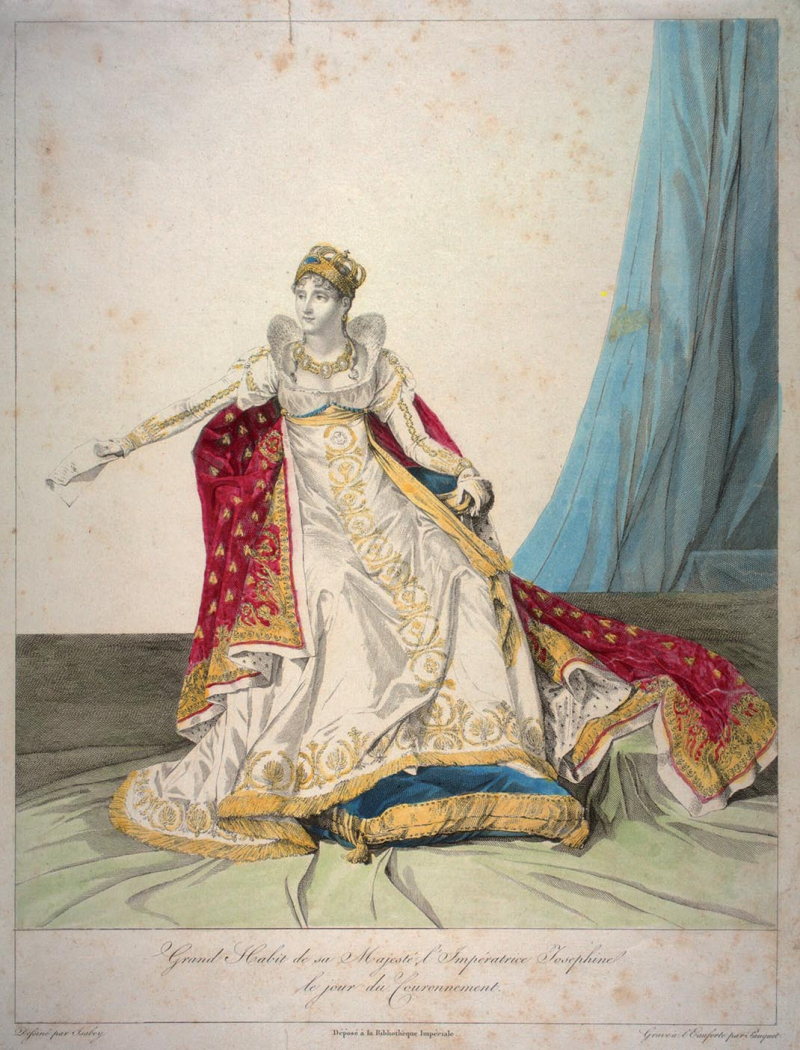 Jean-Louis-Charles Pauquet, after Jean-Baptiste Isabey, Grand Habit de Sa Majesté l’Impératrice Joséphine, le jour du couronnement, First Empire, etching. Montreal, McGill University, Napoleon collection, rare books.
Jean-Louis-Charles Pauquet, after Jean-Baptiste Isabey, Grand Habit de Sa Majesté l’Impératrice Joséphine, le jour du couronnement, First Empire, etching. Montreal, McGill University, Napoleon collection, rare books.
Joséphine’s accompanying mantle, worn for the ceremony at Notre-Dame Cathedral and in coronation portraits, was perhaps more extravagant than the gown itself: 22 meters of crimson velvet (a color chosen to disassociate from the Bourbon’s royal blue) lined and bordered in ermine fur and embroidered in gold with more symbols of Napoléon and his empire, including oak, laurel, and olive leaves, and of course, bees. It was meant to be worn asymmetrically, but the garment was so heavy it was attached with straps at both shoulders. The extreme weight reportedly caused Joséphine to struggle with her balance…but could that have been because her resentful sisters-in-laws tugged at the train while she made her procession, as is rumored?
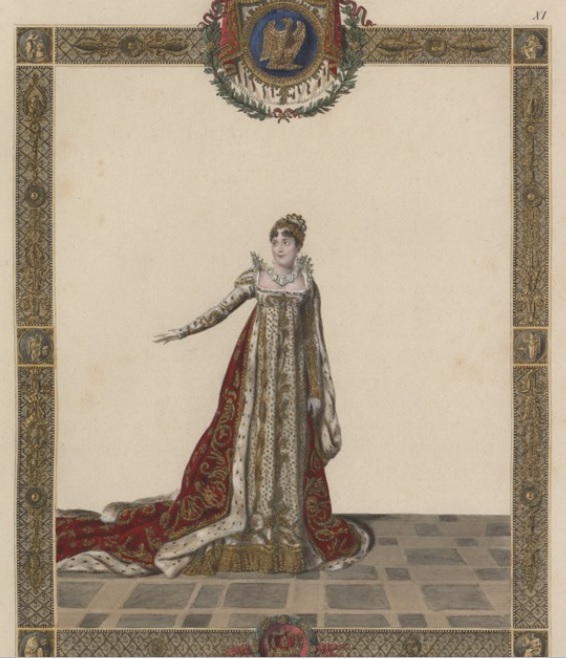
Jean-Baptiste Isabey, "Grand Habillement de L'Impératrice," Livre du Sacre, 1804. Bibliothèque nationale de France.
Several depictions of Empress Joséphine’s coronation costume exist in the form of paintings, etchings, and written descriptions, but not all are consistent. Some differences can be explained by her change from a grand costume at the Notre-Dame ceremony to a petite costume for the remaining rituals. A costume change would certainly be in line with Joséphine's reputation as a clothes horse; she allegedly did not repeat her ensembles and was known to have changed her attire several times a day. Interestingly, select portraits of the newly-crowned Empress Joséphine show her seated, a change from the standing poses of past queens. This was most likely meant to reiterate her place on the throne as Empress and right to rule alongside Napoléon.
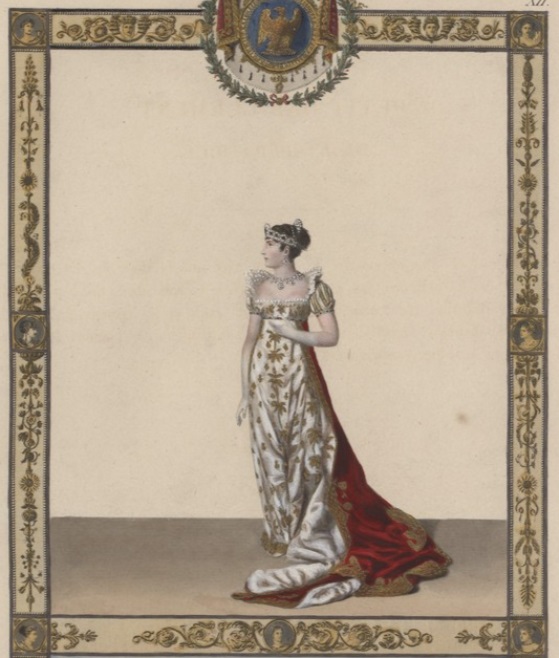
Jean-Baptiste Isabey, "Petit Habillement de L'Impératrice," Livre du Sacre, 1804. Bibliothèque nationale de France.
The FIDM Museum is currently fundraising to acquire an astonishingly rare Napoléonic court ensemble, possibly worn by Empress Joséphine herself, through our Operation 1804 initiative. The gown, the focus of our 2018-2019 exhibition Majesty & Mystery: Saving a Napoléonic Court Gown, is in line with the new rules of court dress set by the coronation, and the gold embroidery features motifs of the empire: bees, roses, and tulips. Operation 1804 supports the purchase of the gown, provenance research, full conservation, and a documentary detailing these processes. In honor of Empress Joséphine's birthday, we encourage you to consider donating $18.04, $1,804.00, or any amount you can contribute to help us preserve this majestic piece of history and solve the exciting mystery of who wore it. Bibliography: Chrisman-Campbell, Kimberly. “The Empress of Fashion: What Joséphine Wore.” In Joséphine and the Arts of the Empire, edited by Eleanor P. DeLorme, 157-174. Los Angeles: J. Paul Getty Museum, 2005. Séguy, Philippe. “Costume in the Age of Napoléon.” In The Age of Napoléon: Costume from Revolution to Empire, 1789-1815, edited by Katell le Bourhis, 23-118. New York: The Metropolitan Museum of Art, 1989. Siegfried, Susan L. “Fashion and the Reinvention of Court Costume in Portrayals of Joséphine de Beauharnais (1794-1809).” Apparence(s) [online], 6, 2015. http://journals.openedition.org/apparences/1329.